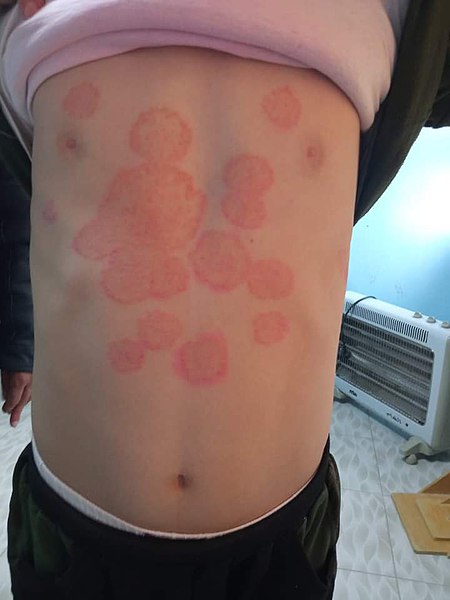Playlist
Show Playlist
Hide Playlist
Onychomycosis on Darker Skin: Epidemiology and Etiology
-
Slides Onychomycosis on Darker Skin Epidemiology and Etiology.pdf
-
Download Lecture Overview
00:00 Welcome to our lecture on Onychomycosis. 00:05 This is fungal infection of the nails or Nico means nail. 00:09 Mycosis. Fungus. Onychomycosis accounts for 50% of nail disorders, meaning that if anyone has nail disorders, almost 50% of the time the patient will have onychomycosis. It's more common in adults than children and often affects the first toenail. It can also involve multiple nails, particularly in immunocompromised patients. 00:41 So let's take a look at the risk factors. 00:44 The first risk factor includes dermatological conditions for example tinea pedis. 00:50 So if you have tinea pedis the chances of you developing onychomycosis are high. 00:56 Psoriasis can also predispose to onychomycosis hyperhidrosis, which is increased sweating, is a high risk for people to develop onychomycosis. The next risk factor is comorbidities. 01:12 People with diabetes mellitus are more prone to developing onychomycosis. 01:17 Those who have HIV infection are also more prone to getting onychomycosis. 01:23 And lastly, trauma can also predispose to onychomycosis as well as poor nail grooming. 01:33 In 75% of cases, onychomycosis is caused by Dermatophytes, T rubrum E, Epidermophyton, Floccosum, and Microsporum species, also known as tinea unguium. 01:48 It can also be caused by non dermatophytes, such as the molds in less than 10% of cases. 01:55 As you can see, Aspergillus and the other species. 01:59 And of course yeasts such as Candida albicans. 02:04 So it's dermatophytes, the molds and yeasts. 02:11 There are a few types of onychomycosis: the distal subungual onychomycosis, superficial white onychomycosis, proximal subungual onychomycosis. 02:23 And there's also lateral onychomycosis. 02:28 So distal subungual onychomycosis is the most common type. 02:34 One gets subungual hyperkeratosis and thickening of the nail plate, and discoloration. In superficial white onychomycosis. 02:46 You get flaky white patches and pits on the top of the nail plate. 02:52 In proximal subungual onychomycosis, the nail plate close to the lunula is thick and discolored, and this is frequently associated with an underlying HIV infection. 03:06 History and physical examination are crucial in making a diagnosis. 03:11 Dermoscopy might also help to differentiate between onychomycosis, traumatic onycholysis and sometimes melanonychia. 03:20 Nail clipping for fungal microscopy and culture is essential. 03:26 Some of the differentials for onychomycosis include psoriasis, and one m ay look for psoriatic plaques somewhere else on the skin. 03:36 And there's also a typical sign that you see on the nails called oil drop sign. 03:42 So it looks like one is dropped oil on the nail. 03:45 And that's the picture that you get in psoriasis. 03:48 Lichen planus is also another differential for onychomycosis. 03:53 And in lichen planus one sees longitudinal ridging and fissuring, as well as thinning and turkey onychia. 04:03 Although 50% of nail dystrophies in adults and 30% in children are due to onychomycosis, confirmation of fungal infection is crucial and mandatory prior to commencing treatment, because antifungals are quite expensive and the treatment may take a long time. 04:24 So looking at management and use of oral antifungals. 04:29 The list that you see here terbinafine, itraconazole, fluconazole are the options that we use for onychomycosis. 04:39 The use of urea paste, perhaps 40% and above, actually increases systemic antifungal efficacy. 04:48 One has to be aware of side effects due to the antifungal drugs, for example hepatotoxicity. 04:55 So in any high risk patient do screen and do your baseline liver function tests. 05:02 So topical treatments are generally less effective than oral for onychomycosis. 05:08 However, if less than 50% of the nail plate is involved, one ma y consider using topical treatments that are available.
About the Lecture
The lecture Onychomycosis on Darker Skin: Epidemiology and Etiology by Ncoza Dlova is from the course Fungal Skin Infections in Patients with Darker Skin.
Included Quiz Questions
What percentage of nail disorders are accounted for by onychomycosis?
- 50%
- 25%
- 75%
- 10%
- 90%
Which type of onychomycosis is most frequently associated with underlying HIV infection?
- Proximal subungual onychomycosis
- Distal subungual onychomycosis
- Superficial white onychomycosis
- Lateral onychomycosis
- Total dystrophic onychomycosis
When is topical antifungal treatment most appropriate to consider for onychomycosis?
- When less than 50% of the nail plate is involved
- When more than 50% of the nail plate is involved
- When the patient has normal liver function tests
- When multiple nails are affected
- When the infection is caused by Candida species
Customer reviews
5,0 of 5 stars
| 5 Stars |
|
5 |
| 4 Stars |
|
0 |
| 3 Stars |
|
0 |
| 2 Stars |
|
0 |
| 1 Star |
|
0 |




